Apostolnik
Apostolnik is a traditional head covering worn by Orthodox Christian women, particularly in Eastern Europe, during religious services. The apostolnik is designed to cover the head, neck, and shoulders, conforming to the Orthodox Christian teachings regarding modesty in dress for women when attending church or participating in public prayers. This head covering is deeply rooted in the cultural and religious traditions of the region, serving as a symbol of piety and respect towards the sacredness of the church environment.
Origin and Significance[edit | edit source]
The tradition of wearing a head covering such as the apostolnik in church is based on interpretations of biblical passages, notably 1 Corinthians 11:5, which discusses the importance of women covering their heads during prayer. The apostolnik, therefore, is not merely a cultural artifact but also a manifestation of adherence to religious doctrine. It symbolizes a woman's commitment to humility and modesty in the presence of God, reflecting a broader understanding of the role of attire in religious observance within the Orthodox Church.
Design and Variations[edit | edit source]
The apostolnik can vary in design, ranging from simple, unadorned pieces to elaborately decorated ones. Materials also vary, with some made from lightweight fabrics for everyday use, and others crafted from luxurious materials for special occasions. The color of the apostolnik is typically white or black, but variations exist depending on regional traditions and personal preferences.
Contemporary Use[edit | edit source]
In contemporary times, the use of the apostolnik has seen variations in adherence. In some regions and communities, it remains a strict requirement for women to wear an apostolnik or a similar head covering during church services. In others, the practice has become more relaxed, with women choosing whether or not to wear it based on personal conviction or cultural identity. The apostolnik thus serves as a point of intersection between tradition, personal faith, and modernity within the Orthodox Christian community.
Cultural Impact[edit | edit source]
Beyond its religious significance, the apostolnik has also played a role in the cultural identity of Orthodox Christian women. It is a visible marker of faith and tradition, often associated with major life events and celebrations such as baptisms, weddings, and religious holidays. The apostolnik, therefore, is not only a garment of modesty and piety but also a carrier of cultural and familial heritage.
See Also[edit | edit source]
Navigation: Wellness - Encyclopedia - Health topics - Disease Index - Drugs - World Directory - Gray's Anatomy - Keto diet - Recipes
Search WikiMD
Ad.Tired of being Overweight? Try W8MD's physician weight loss program.
Semaglutide (Ozempic / Wegovy and Tirzepatide (Mounjaro / Zepbound) available.
Advertise on WikiMD
WikiMD is not a substitute for professional medical advice. See full disclaimer.
Credits:Most images are courtesy of Wikimedia commons, and templates Wikipedia, licensed under CC BY SA or similar.Contributors: Prab R. Tumpati, MD

